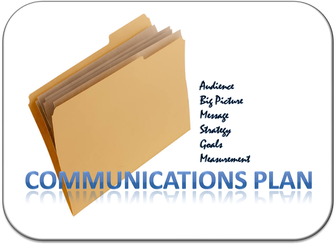 Want to make sure you're communicating the right message to the right audience in the right way? You probably need a communications plan. A communications plan is a good opportunity for your team to step back from the daily grind and spend some time contemplating the big picture. If you’re embarking on a new business venture, launching a program or just need to reevaluate, it may be a good time to do a plan. A communications plan need not be all that difficult. It doesn't have to be War and Peace. It can be an outline or a series of bullet points. Start with a format that’s easiest for you. Purpose of a plan
A plan is good way to organize your thoughts and actions. A plan helps to clarify what it is you want to accomplish (the goal), how you’ll articulate it (the message), whom you want to reach (the audience), how to do it (strategy and tactics), and then how to tell if your plan is working (measurement). This is just one way to organize a communications plan, but you get the gist. In part one of our three-part blog post on writing a communications plan, we’ll tackle identifying the goals and messages. Establishing goals You’d think this would be easy, and often it is. The goal might be to increase the number of members in your association. Or maybe you want to oppose legislation that would be a burden to your industry. But, sometimes identifying goals can be harder to nail down. Maybe you want to raise the profile of your corporation in a certain geographic area, to win more business. Or, maybe you want to generate positive media coverage in the wake of negative press. The next step is honing a message or messages that support your goals. Honing a message Let’s say the goal is to recruit 100 new members to your professional association. What kind of messages would reinforce this goal? Examples might be:
0 Comments
Leave a Reply. |
tags
All
Archives
March 2019
|
Photos from Meet the Media Guru, Joseph.Morris, BoldContent, MDGovpics, Grzegorz Łobiński, Mr Moss, North Charleston, ITU Pictures, wistechcolleges, .v1ctor Casale., www.audio-luci-store.it, katielips, editor64, NeighborLink Fort Wayne, AMagill, timsackton, MyFWCmedia, Matt J Newman, Mr.TinDC, Skley, mikecogh, othompsonski, wayne's eye view, Elvert Barnes, woodleywonderworks, North Charleston, MoBikeFed, flossyflotsam, North Charleston, NYCDOT, US Mission Geneva, jjandames, aalborgstift, BurnAway, A. Germain, North Charleston, NCDOTcommunications, IAEA Imagebank, The Chapman Cultural Center, hitsnooze, Wiertz Sébastien, charliekwalker, cliff1066™, TheeErin, woodleywonderworks, dane brian, Aramil Liadon, 2010 World Wheelchair Basketball Championships, Ty Nigh, freddthompson, Nadia Szopinska, west.m, stormwarning., Bright Meadow, Giorgio Montersino, Chris Erwin, Aplomb, jfingas, joce01_y, Massachusetts Dept. of Environmental Protection, Kevin Walter, Andrew Feinberg, Yan Arief, kellypretzer, Korean Resource Center 민족학교, veDro - l'Italia al futuro, crdotx, US Mission Geneva, Joe Shlabotnik, esocialmediashop, Stephen Cummings, CarbonNYC, sidewalk flying, MoBikeFed, marksdk, Marco Raaphorst, Saleel Velankar, adactio, edkohler, World Economic Forum, USACE Europe District, stereogab, Florin Rosoga, MikeSchinkel

